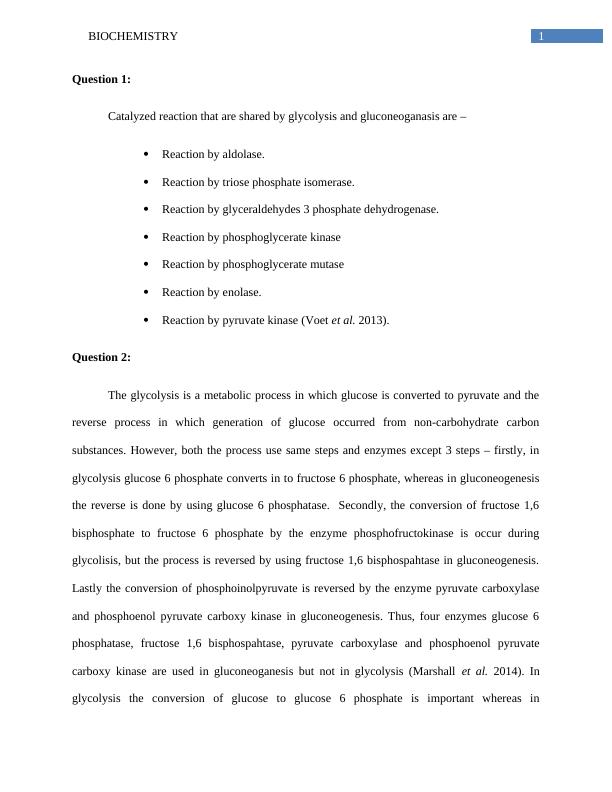Biochemistry: Glycolysis and Gluconeogenesis
Added on 2023-06-10
6 Pages1123 Words414 Views
Running head: BIOCHEMISTRY
BIOCHEMISTRY
Name of the student:
Name of the University:
Author note:
BIOCHEMISTRY
Name of the student:
Name of the University:
Author note:

1BIOCHEMISTRY
Question 1:
Catalyzed reaction that are shared by glycolysis and gluconeoganasis are –
Reaction by aldolase.
Reaction by triose phosphate isomerase.
Reaction by glyceraldehydes 3 phosphate dehydrogenase.
Reaction by phosphoglycerate kinase
Reaction by phosphoglycerate mutase
Reaction by enolase.
Reaction by pyruvate kinase (Voet et al. 2013).
Question 2:
The glycolysis is a metabolic process in which glucose is converted to pyruvate and the
reverse process in which generation of glucose occurred from non-carbohydrate carbon
substances. However, both the process use same steps and enzymes except 3 steps – firstly, in
glycolysis glucose 6 phosphate converts in to fructose 6 phosphate, whereas in gluconeogenesis
the reverse is done by using glucose 6 phosphatase. Secondly, the conversion of fructose 1,6
bisphosphate to fructose 6 phosphate by the enzyme phosphofructokinase is occur during
glycolisis, but the process is reversed by using fructose 1,6 bisphospahtase in gluconeogenesis.
Lastly the conversion of phosphoinolpyruvate is reversed by the enzyme pyruvate carboxylase
and phosphoenol pyruvate carboxy kinase in gluconeogenesis. Thus, four enzymes glucose 6
phosphatase, fructose 1,6 bisphospahtase, pyruvate carboxylase and phosphoenol pyruvate
carboxy kinase are used in gluconeoganesis but not in glycolysis (Marshall et al. 2014). In
glycolysis the conversion of glucose to glucose 6 phosphate is important whereas in
Question 1:
Catalyzed reaction that are shared by glycolysis and gluconeoganasis are –
Reaction by aldolase.
Reaction by triose phosphate isomerase.
Reaction by glyceraldehydes 3 phosphate dehydrogenase.
Reaction by phosphoglycerate kinase
Reaction by phosphoglycerate mutase
Reaction by enolase.
Reaction by pyruvate kinase (Voet et al. 2013).
Question 2:
The glycolysis is a metabolic process in which glucose is converted to pyruvate and the
reverse process in which generation of glucose occurred from non-carbohydrate carbon
substances. However, both the process use same steps and enzymes except 3 steps – firstly, in
glycolysis glucose 6 phosphate converts in to fructose 6 phosphate, whereas in gluconeogenesis
the reverse is done by using glucose 6 phosphatase. Secondly, the conversion of fructose 1,6
bisphosphate to fructose 6 phosphate by the enzyme phosphofructokinase is occur during
glycolisis, but the process is reversed by using fructose 1,6 bisphospahtase in gluconeogenesis.
Lastly the conversion of phosphoinolpyruvate is reversed by the enzyme pyruvate carboxylase
and phosphoenol pyruvate carboxy kinase in gluconeogenesis. Thus, four enzymes glucose 6
phosphatase, fructose 1,6 bisphospahtase, pyruvate carboxylase and phosphoenol pyruvate
carboxy kinase are used in gluconeoganesis but not in glycolysis (Marshall et al. 2014). In
glycolysis the conversion of glucose to glucose 6 phosphate is important whereas in

2BIOCHEMISTRY
gluconeogenesis the reverse is important in order to generate free glucose, thus, glucose 6
phosphatase is used that helps to hydrolyze glucose 6 phosphate and produce phosphate group
and free glucose. In glycolysis conversion of fructose 6 phosphate to fructose 1,6 bisphosphate is
done by using phosphofructokinase, but the reaction is one directional, thus another enzyme
fructose 1,6 bisphosphatase is used to reveresd the reaction.in gluconeogenesis. In
gluconeogenesis the conversion of pyruvate to phosphoinolpyruvate is important in order to
reverse the process of glycolysis and produce glucose from non-carbohydrate carbon resource.
Thus, the enzyme pyruvate carboxylase is used that helps in carboxylation of pyruvate and
produce oxaloacetae. The oxaloacetate then converts into phosphoinolpyruvate by the enzyme
phosphoenol pyruvate carboxy kinase (Voet et al. 2013).
Question 3:
The reaction that includes conversion of oxaloacetate into phosphoinolpyruvate is
occurred in the gluconeogenesis pathway but not in glycolysis (option c) (Voet et al. 2013).
Question 4:
An increase in glucagon levels can promote the degradation of glycogen i.e.,
glycogenolysis and it occurs during the fasting state or starvation (option d) (Voet et al. 2013).
Question 5:
As the girl is fasting from several days thus the glucose level will decrease and the liver
will produce the glucose through gluconeogenesis in order to maintain the glucose level in the
body and produce energy for carry out the function of the body (Option c) (Vasudevan,
Sreekumari and Vaidyanathan 2013).
gluconeogenesis the reverse is important in order to generate free glucose, thus, glucose 6
phosphatase is used that helps to hydrolyze glucose 6 phosphate and produce phosphate group
and free glucose. In glycolysis conversion of fructose 6 phosphate to fructose 1,6 bisphosphate is
done by using phosphofructokinase, but the reaction is one directional, thus another enzyme
fructose 1,6 bisphosphatase is used to reveresd the reaction.in gluconeogenesis. In
gluconeogenesis the conversion of pyruvate to phosphoinolpyruvate is important in order to
reverse the process of glycolysis and produce glucose from non-carbohydrate carbon resource.
Thus, the enzyme pyruvate carboxylase is used that helps in carboxylation of pyruvate and
produce oxaloacetae. The oxaloacetate then converts into phosphoinolpyruvate by the enzyme
phosphoenol pyruvate carboxy kinase (Voet et al. 2013).
Question 3:
The reaction that includes conversion of oxaloacetate into phosphoinolpyruvate is
occurred in the gluconeogenesis pathway but not in glycolysis (option c) (Voet et al. 2013).
Question 4:
An increase in glucagon levels can promote the degradation of glycogen i.e.,
glycogenolysis and it occurs during the fasting state or starvation (option d) (Voet et al. 2013).
Question 5:
As the girl is fasting from several days thus the glucose level will decrease and the liver
will produce the glucose through gluconeogenesis in order to maintain the glucose level in the
body and produce energy for carry out the function of the body (Option c) (Vasudevan,
Sreekumari and Vaidyanathan 2013).

End of preview
Want to access all the pages? Upload your documents or become a member.
Related Documents
Energy Processes in Exercise Sciencelg...
|6
|1048
|235
Process of Energy Production by Aerobic Respirationlg...
|10
|1727
|293
Exercise Physiology Assignmentlg...
|6
|1798
|98
Allosteric Inhibition in Enzymes: Mechanism and Exampleslg...
|5
|682
|356
Fructose-1, 6-Bis-Phosphatase- Deficiency and Health Impactlg...
|7
|1527
|107